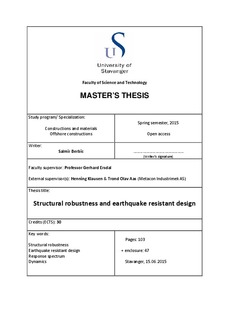| dc.contributor.author | Berbic, Salmir | |
| dc.date.accessioned | 2015-09-14T08:40:31Z | |
| dc.date.available | 2015-09-14T08:40:31Z | |
| dc.date.issued | 2015-06-15 | |
| dc.identifier.uri | http://hdl.handle.net/11250/299674 | |
| dc.description | Master's thesis in Structural engineering | nb_NO |
| dc.description.abstract | The subject of the thesis is evaluation of possible modification of the structures dynamic characteristics, within the context of increasing its level of robustness and resistance to earthquake actions. The idea and suggested approach of design in this thesis is based on the solutions to the design challenges of The Rion-Antirion Bridge. The bridge is a good example of an approach of design, which gives the structure features of adapting to various load scenarios.
The scope of this thesis is to assess the suitability of such an approach of design for buildings in Norway where earthquake actions are considered, and suggest design procedures for earthquake resistant design by alternative design methods within the context of structural robustness and the design approach of applying adaptive features to the structure.
As assumed and discussed in this thesis, there is a direct correlation between a structures stiffness characteristics and the resulting force from earthquake actions. Approach of design methods, which gives the structure features of adapting to various load scenarios are discussed, presented and analyzed in the thesis. Based on the results of the analyses, this approach of design should be considered for structures where the probability of earthquake events are relatively low, yet sets the design criteria.
Initiation to the modification of the structures dynamic characteristics are based on the principle of known failure and sacrificial elements. One of the discussed ideas is to apply viscous dampers to the wind-bracing system combined with a sacrificial element locking the damper until the system is exposed to an earthquake or similar accidental extreme events.
The suggested design procedure and robustness-increasing methods discussed in this thesis are applied to a practical example of an existing structure and assessed based on results from vibration- and response spectrum analyses. Based on the analyses results, it is concluded that the suggested design procedure along with the robustness-increasing methods discussed, results in favorable and desirable features to the building. Cost-beneficial analyses (CBA) are not performed in this thesis, but since the discussed design approach gives the opportunity to design the structure based on criteria set by often-occurring environmental loads instead of unusual earthquake loads, it is assumed that it may reduce the cost factor, without compensating on the structures safety level. | nb_NO |
| dc.language.iso | eng | nb_NO |
| dc.publisher | University of Stavanger, Norway | nb_NO |
| dc.relation.ispartofseries | Masteroppgave/UIS-TN-IKM/2015; | |
| dc.rights | Navngivelse-Ikkekommersiell 3.0 Norge | * |
| dc.rights.uri | http://creativecommons.org/licenses/by-nc/3.0/no/ | * |
| dc.subject | materialteknologi | nb_NO |
| dc.subject | byggkonstruksjon | nb_NO |
| dc.subject | konstruksjonsteknikk | nb_NO |
| dc.subject | jordskjelv | nb_NO |
| dc.subject | earthquake resistant design | nb_NO |
| dc.title | Structural robustness and earthquake resistant design | nb_NO |
| dc.type | Master thesis | nb_NO |
| dc.subject.nsi | VDP::Technology: 500::Building technology: 530::Construction technology: 533 | nb_NO |
| dc.source.pagenumber | 150 | nb_NO |

